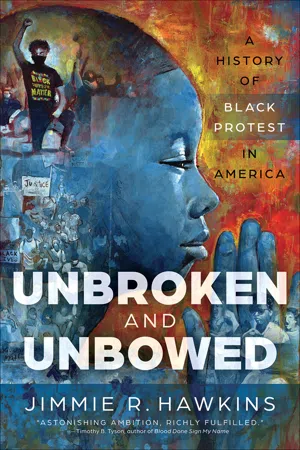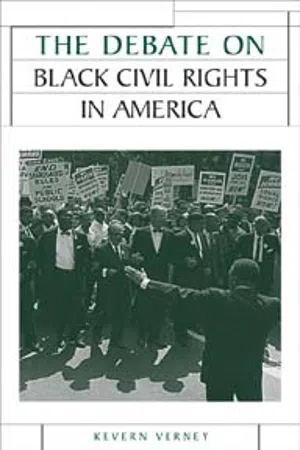Civil Rights Protests
Civil rights protests refer to organized demonstrations and actions aimed at achieving equal rights and ending discrimination against marginalized groups, particularly African Americans in the United States. These protests were pivotal in the struggle for civil rights and led to significant legislative and societal changes, such as the Civil Rights Act of 1964 and the Voting Rights Act of 1965.
5 Key excerpts on "Civil Rights Protests"
- eBook - ePub
Unbroken and Unbowed
A History of Black Protest in America
- Jimmie R. Hawkins(Author)
- 2022(Publication Date)
- Westminster John Knox Press(Publisher)
...In contrast with the African and Colored movements, its total platform was a public one—to disrupt life in the country as a form of protest. Similar to past generations, once white terrorists discovered the identities of the leadership of this movement, its members paid dearly, often with their lives. But they were willing to risk arrest, brutal beatings, and domestic terrorism to effect change. This generation embraced civil disobedience in order to sway public opinion and move politicians to action, and it demonstrated success by using the authority of the federal government to implement national change. The civil rights movement was the most impactful human rights campaign in the history of the United States of America. It has been considered the second act of the first civil rights movement, the abolitionist movement of 1775–1865. The civil rights movement of the 1950s and 1960s was a continuation of the struggle to eliminate centuries of white supremacy infused in American society. Its uniqueness was that in just two decades it achieved tangible results and served as the catalyst for dismantling public approval of racism. Victories in the courts, congressional legislation, and triumphs both nationally and locally were monumental achievements. But many paid a terrible price of destruction of property, time spent in jail, and loss of life. It comprises an epic story of heroes such as Rosa Parks, Martin Luther King Jr., Bayard Rustin, and John Lewis. It also has villains such as Sherriff Bull Conner and Governor George Wallace. It has a list of characters widely ranging from presidents of the United States to unknown childhood marchers. It is a story of perseverance and protest in the face of insurmountable odds. Yet because they would not give up, it is the story of change coming to America. The brief, three-decade period between 1955 and 1987 resulted in an intense emotional and intellectual wrestling over Black identity...
- eBook - ePub
- Kevern Verney(Author)
- 2017(Publication Date)
- Manchester University Press(Publisher)
...In this important turning point in marking the recognition of the role of women in the movement, Evans argued that the involvement of women in civil rights protest was a prelude to their later participation in the women’s liberation movement. A different, but related, development came in the proliferation of local and regional studies. In 1980 William Chafe’s Civilities and Civil Rights recounted the history of civil rights protest in Greensboro, North Carolina, birthplace of the student ‘sit-in’ movement of the 1960s. In a leading article published the same year, J. Mills Thornton III looked at the Montgomery Bus Boycott. These accounts were followed by widely acclaimed local studies on Tuskegee, Alabama, by Robert J. Norrell and St Augustine, Florida, by David R. Colburn. 15 Sociologist Aldon Morris’s 1984 study, The Origins of the Civil Rights Movement was also influential, stressing the importance of social and economic change at grassroots level in the emergence of organized civil rights protest. Morris was one of the first scholars to challenge the traditional ‘Montgomery to Memphis’ chronology of the civil rights struggle adopted by earlier scholars, who had portrayed the emergence of Martin Luther King in the 1955 Montgomery Bus Boycott as marking the birth of the Civil Rights Movement and his death in Memphis thirteen years later as heralding its final demise. Instead, Morris drew attention to earlier protest activity, most notably the 1953 Bus Boycott in Baton Rouge, Louisiana...
- eBook - ePub
Inquiry-Based Lessons in U.S. History
Decoding the Past (Grades 5-8)
- Jana Kirchner, Andrew McMichael(Authors)
- 2021(Publication Date)
- Routledge(Publisher)
...A key component of the campaign was the philosophy of civil disobedience and nonviolence successfully employed by Mahatma Ghandi in India. Protestors were instructed to dress well, be neat in appearance, polite, and above all to never engage in any kind of violence. A series of events seemed to indicate a quickening pace for the Civil Rights Movement. In 1955, Rosa Parks refused to surrender her seat on a Montgomery, AL, bus, sparking her arrest and a successful boycott of the public bus system by African Americans. When Arkansas Governor Orville Faubus tried to use National Guard troops to prevent integration of Little Rock schools, President Eisenhower nationalized the Guard and activated the U.S. Army to ensure compliance. A series of lunch counter sit-ins by African Americans across the South successfully desegregated eating many establishments. In the early 1960s national civil rights groups as well as Black and White students from across the U.S. worked to register African Americans disenfranchised by restrictive voting rights laws. They were frequently met with sometimes extreme violence. In 1963, civil rights leader Martin Luther King, Jr., gave his “I Have a Dream” speech on the steps of the Lincoln Memorial, outlining his vision for equality in America. After his arrest later that year in Birmingham, AL, a horrified national television audience watched as local police used fire hoses and dogs to attack children, teenagers, and adults peacefully demonstrating for their Constitutional rights. Meanwhile, the Soviet Union employed Cold War propaganda to argue that Soviet citizens enjoyed more equality than those in supposedly democratic America. Worried about its status as “leader of the free world,” American politicians began to argue for a series of national civil rights laws. Following President John F. Kennedy’s assassination in 1963, President Lyndon B...
- Peter Joyce(Author)
- 2015(Publication Date)
- Teach Yourself(Publisher)
...The focus of protesters’ concerns is often public policy, although the commercial practices of business concerns may also inspire protests. Protest is frequently viewed as a key freedom in a liberal democratic political system. For this reason, the right to peaceful process is embodied in codified constitutions or similar documents. The First Amendment to the American Constitution (ratified in 1791) prohibited Congress from making any law ‘ abridging the freedom of speech, or of the press; or the right of the people peaceably to assemble, and to petition the Government for a redress of grievances ’. Similarly, Article 11 of the European Convention on Human Rights requires all nations that have signed up to this document to uphold the freedom of assembly and association. Key idea (2) Protest is carried out through a wide range of methods that include petitions, demonstrations, direct action, civil disobedience, and industrial disputes. The intention is to secure changes in public or commercial policy. Petitions Petitions entail citizens ‘signing up’ to a proposal that may express opposition to an aspect of public policy protesters wish to change. The aim of this form of protest is that widespread public support for the aims of the petition will convince governments that they need to react in a positive manner in order to reduce the likelihood of the petitioners refusing to support them in the next national election. The issue(s) raised in the petition may relate to local or national policy, and in many countries is a time-honoured way of conducting protest. In more recent years, issues of global importance have been raised in this manner including Jubilee 2000, which was a coalition of around 100 voluntary groups that organized a four-year campaign seeking to have the debts of 52 of the heavily indebted developing nations cancelled in order to release funds for programmes to eradicate poverty in these countries...
- eBook - ePub
The Black Experience in America
From Civil Rights to the Present
- Britannica Educational Publishing, Jeff Wallenfeldt(Authors)
- 2010(Publication Date)
- Britannica Educational Publishing(Publisher)
...CHAPTER 2 T HE C IVIL R IGHTS M OVEMENT AND F REEDOM S TRUGGLE I n February 2010, Pres. Barack Obama and first lady Michelle Obama hosted “In Performance at the White House: A Celebration of Music from the Civil Rights Movement,” a concert featuring songs from the civil rights movement as well as readings from civil rights speeches and writings. That Obama was the first African American to hold the country’s highest office lent special significance to the evening. The event was held in honour of Black History Month, during which the study of the civil rights movement and freedom struggle are central. THE MOVEMENT The civil rights movement that came to prominence during the mid-1950s in the United States had its roots in the centuries-long efforts to abolish slavery. Through nonviolent protest the civil rights movement of the 1950s and ‘60s broke the pattern of public facilities being segregated by “race” in the South and achieved the most important breakthrough in equal-rights legislation for African Americans since the Reconstruction period (1865–77). By the mid-1960s some saw their struggle as a freedom movement not just seeking civil rights reform but instead confronting the enduring economic, political, and cultural consequences of past racial oppression. A BOLITIONISM TO J IM C ROW American history has been marked by persistent and determined efforts to expand the scope and inclusiveness of civil rights. Although equal rights for all were affirmed in the founding documents of the United States, that affirmation did not include many of the new country’s inhabitants, who were denied essential rights. African slaves and indentured servants did not have the unalienable right to “life, liberty, and the pursuit of happiness” that British colonists asserted to justify their Declaration of Independence...




